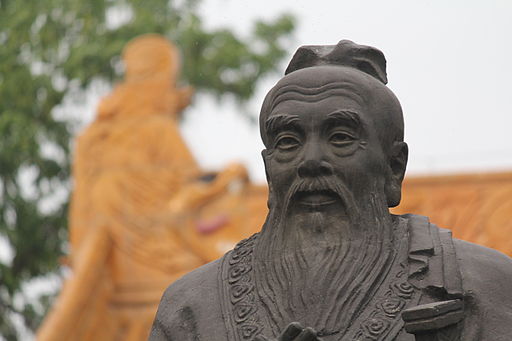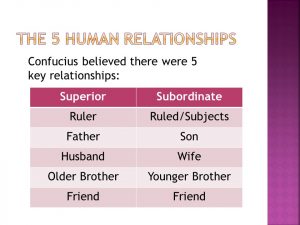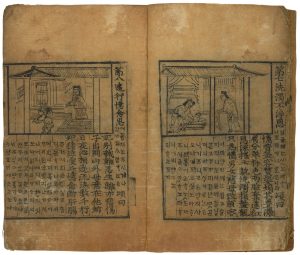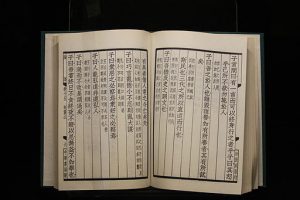6 Confucian Thought

Confucianism was the official religion of China from 200 BCE until it was officially abolished when communist leadership discouraged religious practice in 1949. The religion was developed by “Confucius”, which is the name by which English speakers know Kong Qiu 孔丘, born near a small ducal state on the Shandong Peninsula in 551 BCE. His teaching encouraged personal and governmental morality and the importance of correct social and familial relationships. These ideals, if followed, would lead to a world of peace, justice, kindness and order.
Meeting the Master
We have open access materials from Robert Eno[1] of the University of Indiana, made available for educators.
“Confucius’s father was a member of the low aristocracy of the medium sized state of Lu 魯. According to our best sources, he was an important aide to a major aristocratic, or “grandee” family. During his prime, this family had served the greatest power holders in Lu by controlling a domain assigned to them on Lu’s southern border, near a small, non-Zhou cultural area called Zou 鄹. Shortly before Confucius’s birth, the family’s domain was relocated to the north, but Confucius’s father, having by his primary wife and his concubines produced no healthy sons to carry on his line, and being now an older man, chose at this time to take as a concubine a woman of Zou. She soon gave birth to Confucius. Three years later, Confucius’s father died, and Confucius apparently grew up with his mother’s family in the border region between Lu and Zou. Reaching adulthood, he traveled to the feudal center of Lu to seek social position, based on his father’s standing and connections.
When Confucius sought his fortune in Lu, he probably appeared there as a semi-outsider, the son of a “mixed” union between a man of Lu, who had long resided in Zou, and a woman of that non-Zhou place. But Confucius made his reputation as a strong advocate of a puristic revival of Zhou traditions in court conduct, religious ceremony, and every aspect of ordinary life. He became expert in these traditions, and it was on the basis of this knowledge and the persuasiveness of his claim that the way to bring order back to “the world” was to recreate early Zhou society through its ritual forms, or “li,” that Confucius became known. The details of what Confucius saw as legitimate Zhou culture and why he thought its patterns were tools for building a new utopia are the principal subjects of the Analects.
His mastery of Zhou cultural forms allowed Confucius to become a teacher of young aristocrats seeking polish, and through their connections, he was able to gain some stature in Lu. Ultimately, he and some of his followers attempted to implement a grand restorationist plan in Lu that would have shifted power back to the ducal house. Shortly after 500 BCE, when Confucius was about fifty, the plan failed, and Confucius was forced to leave his home state. For about fifteen years, he traveled with a retinue of disciples from state to state in eastern China, looking for a ruler who would employ him and adopt the policies he advocated. The Analects pictures some key moments in these travels, which ultimately proved fruitless. A few years before his death, one of Confucius’s senior disciples, a man named Ran Qiu, arranged to have Confucius welcomed back to Lu, where he lived out his days as a teacher of young men, training them in the literary, ritual, and musical arts that he saw as central to the culture of the Zhou.
An extraordinary teacher, his lessons—which were about self-discipline, respect for authority and tradition, and jen (the kind treatment of every person)—were collected in a book called the Analects.”
Some religious scholars consider Confucianism more of a social system than a religion because it focuses on sharing wisdom about moral practices but doesn’t involve any type of specific worship; nor does it have formal objects. In fact, its teachings were developed in context of problems of social anarchy and a near-complete deterioration of social cohesion. Dissatisfied with the social solutions put forth, Confucius developed his own model of morality to help guide society.
Additional Reading
For more detail, read Columbia University’s page on Confucius and the Confucian Tradition, part of their materials on Living in the Chinese Cosmos: The Three Teachings
Confucius focused on human fulfillment in the social work–through relationships– for he believed that the way of life flowed through the human world just as it did in the rest of nature. Troubled by the political turmoil and what he perceived as a decline in civilization during his lifetime (you might want to read more about this, as China was in political turmoil at the time he lived), Confucius advocated installing a program of comprehensive education and the cultivation of special virtues in all people. He wanted to develop individuals who could be social leaders and who could create a harmonious society. In Confucian thinking, to a great extent, human beings are who they are because of their relationships. Careful attention to the duties and obligations of a person’s different relationships with others was a central focus of his teaching. One must live up to the highest expectations or standards of various social roles one occupied, beginning with the family. (xaio)
who they are because of their relationships. Careful attention to the duties and obligations of a person’s different relationships with others was a central focus of his teaching. One must live up to the highest expectations or standards of various social roles one occupied, beginning with the family. (xaio)
So being a dutiful child, caring spouse, responsible parent, thoughtful friend–these are all the things that he emphasized in his teachings about how to achieve an ethical society. His emphasis was always on the community, not the individual’s well-being.
The excellent or noble person (junzi) would have an inner integrity and a deep consideration for others (ren). This person would have mastered the social graces—all those countless rituals of propriety (li) that allow for smooth interaction between people. The noble person would avoid extremes in life, maintaining equilibrium and harmony. Additionally, the aesthetic self would be developed, demonstrated in a love for all the arts associated with civilization, such as poetry and literature, calligraphy, dance, painting, and music (wen). By automatically choosing to do what is right (after years of practice and study and by fulfilling one’s job duties and social obligations properly), one would be united with the force of the universe, and the ancestors.

Confucianism is one of the Three Teachings of China, its three most influential religious and philosophical systems. Confucianism became state-sponsored during the Han dynasty (202 BCE – 220 CE). Buddhism and Daoism blended, in ritual and practice, with Confucianism and created a popular set of religious practices, some of which are still a part of Chinese practice.
A short timeline of Confucian impact on Chinese culture:
551 to 479 BCE Life and teaching of Confucius
470-c.380 BCE Arguments against Confucian teachings by Mozi
372-289 BCE Confucian revival
221-202 BCE Confucianism is suppressed by the Qin Dynasty.
136 BCE The Han Dynasty introduces civil service examinations modelled on Confucian texts.
9th century CE Confucianism is reborn as Neo-Confucianism.
Example of modern interpretation

The Analects (translation, Robert Eno)
“The Analects of Confucius, which is composed of about five hundred independent passages, is divided into twenty “books.” Some of these books seem to have originated as strips authored, over a period of years, by a single group, and separated into bundles according to dominant themes. Others of the books seem to have originated independently, and been brought together with the larger number of books at a later date. Within each book, the order of passages appears to have been disrupted over time, to greater or lesser degree, either by disarrangements that occurred after the string of a bundle broke, or because part of the composition process involved conscious rearrangement and insertion of later passages into existing bundles / books, in order to adjust the way the message of the overall text was conveyed. All of the books bear the traces of rearrangements and later insertions, to a degree that makes it difficult to see any common thematic threads at all. If a full account of these alterations in the text could be made, it would likely provide a clear and valuable reflection of the way that the Confucian school and its various branches developed over the first two or three centuries of the school’s existence. Recent finds of early manuscripts dating from c. 300 BCE have thrown additional light on these processes of text development
Although this is not clear on initial reading, the ideas of the Analects are importantly influenced by the literary character of the text, and the fact that it is presented chiefly as conversational interplay among a relatively limited cast of characters: Confucius (“the Master”), his disciples, and a group of power holders with whom Confucius interacts. The Analects was almost certainly used as a teaching text for later generations of disciples, who were taught not only the text but much detail about the contexts and characters now lost to us, and it is certain that the original audience of the text developed a grasp of the rich nuances conveyed by the way statements in the text are distributed among its various speakers. Most importantly, the disciples in the Analects provided a range of positive and negative models readers could emulate as they attempted to find their way into Confucian teachings, and develop into the true inheritors of the Dao of discipleship.
Example: What are the main teachings of Confucius?
Dr. Anu Mande is professor of World History courses at Fullerton College in California. She also has a Youtube Channel with some excellent materials. Here is a short presentation on Confucian thought, and if you would like to focus on the 5 Great Relationships, start at 17:20 in the video. The whole video (21:36 minutes) is well worth watching!
The philosophy conveyed through the Analects is basically an ethical perspective, and the text has always been understood as structured on a group of key ethical terms. These (along with some terms key to other early streams of Chinese thought) are discussed in more detail in the Glossary to follow.
There is a group of key terms whose meaning seems to be so flexible, subtle, and disputed that it seems best to leave them untranslated, simply using transcription for them.
The first set of these terms include:
Ren 仁 – a comprehensive ethical virtue: benevolence, humaneness, goodness; the term is so problematic that many Analects passages show disciples trying to pin Confucius down on its meaning (he escapes being pinned).
Junzi 君子 – often used to denote an ideally ethical and capable person; sometimes simply meaning a power holder, which is its original sense.
Dao 道 – a teaching or skill formula that is a key to some arena of action: an art, self-perfection, world transformation.
Li 禮– the ritual institutions of the Zhou, of which Confucius was master; the range of behavior subject to the broad category denoted by this term ranges from political protocol to court ceremony, religious rite to village festival, daily etiquette to disciplines of personal conduct when alone.
Tian 天 – carrying the basic meaning of “sky,” Tian becomes a concept of supreme deity, often translated as “Heaven,” sometimes possessing clear anthropomorphic features, sometimes appearing more a natural force.
In addition to these items, other complex key terms are rendered by very vague
English words, the meaning of which can only emerge as contextual usage is noted.
Two more difficult terms include:
de 德 – a very complex concept, initially related to the notion of charisma derived from power and gift-giving, developing into an ethical term denoting self-possession and orientation towards moral action. “Virtue” might be a possible choice of translations
wen 文 – denoting a relation to features of civilization that are distinctive to Zhou culture, or to traditions ancestral to the Zhou; wen can refer to decoration, written texts, and personal conduct, but most importantly, it points to the behavioral matrix underlying Zhou li. “Pattern” could be a simple, if inadequate, translation.
Finally, a set of important terms can be translated with some accuracy into English, but only with the understanding that the conceptual range of the Chinese term may not match English perfectly; in some cases, alternate English translations are used.
These include:
Right / Righteousness (yi 義)– often a complement to ren, denoting morally correct action choices, or the moral vision that allows one to make them.
Loyalty (zhong 忠) – denoting not only loyalty to one’s superiors or peers, or to individuals, but also to office; an alignment of self with the interests of others, or of the social group as a whole.
Trustworthiness / Faithfulness (xin 信) – derived from the concept of promise keeping, meaning reliability for others, but also unwavering devotion to principle.
Respectfulness / Attentiveness (jing 敬) – derived from the notion of alertness, and fusing the attentiveness to task characteristic of a subordinate and the respect for superiors that such attentiveness reflects.
Filiality (xiao 孝)– a traditional cultural imperative, obedience to parents, raised to a subtle level of fundamental self-discipline and character building.
Valor (yong 勇) – in a feudal era marked by incessant warfare, bold warriors and adventurers were common; for Confucians, valor concerns risk taking on behalf of ethical principle.
These terms help convey the emphasis on relationship, obedience, ethics, and social structure that are found at the heart of Confucian ideals.
Key Takeaway: Modern ideas about Confucian Thought
Check out these simple articles from Harvard’s Pluralism Project on the ideas in Confucian thought and how they traveled to America.
How Confucius influenced–and still influences!–China
“Imperial China was famous for its civil service examination system, which had its beginnings in the Sui dynasty (581-618 CE) but was fully developed during the Qing dynasty. The system continued to play a major role, not only in education and government, but also in society itself, throughout Qing times.”
“In Our Time, Confucius.” Edited by Melvyn Bragg, BBC Radio 4, BBC, 1 Nov. 2001, www.bbc.co.uk/programmes/p00547k8.
Eno, Robert. The Analects of Confucius, University of Indiana, 2015, chinatxt.sitehost.iu.edu/Analects_of_Confucius_(Eno-2015).pdf.
Hold faithfulness and sincerity as first principles. (2011). In Big ideas simply explained: the philosophy book. Dorling Kindersley Publishing, Inc. Credo Reference: http://lscproxy.mnpals.net/login?url=https://search.credoreference.com/content/entry/dkphilbook/hold_faithfulness_and_sincerity_as_first_principles/0.embed?institutionId=6500
“Confucianism.” The Pluralism Project, Harvard University, 13 Nov. 2014, pluralism.org/confucianism.
Mande, Anu. Confucianism Explained, 10 June 2020, youtu.be/Bj9JaYxsP4U.
Asia for Educators, Columbia University. “Confucius and the ‘Confucian Tradition.’” Living in the Chinese Cosmos | Asia for Educators, 2021, afe.easia.columbia.edu/cosmos/ort/confucianism.htm.
- https://ealc.indiana.edu/people/eno-robert.html ↵



